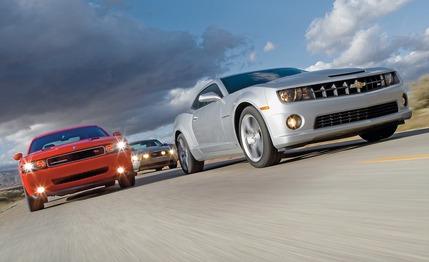
 Comparison Tests
Comparison Tests
If you smoked your draft card or watched the white-suit shuffle from Tranquility Base, you may remember our last V-8 three-way with Chevy, Dodge, and Ford muscle coupes [March 1968]. Who knew then that a rematch would take 40 years? Or that the Earth would tilt so much in the meantime?
Pasadena’s little old lady is in Forest Lawn, and two of the three lords of Detroit are now government-dependent basket cases. You’d be playing long odds to believe this test will ever be repeated. Tune in to the hybrid comparison elsewhere in this issue to see what’s on the White House’s must-have list.
And those all-American, mag-wheeled, sloppy double cheeseburgers we call muscle cars? They’ve gone international, baby. Australians engineered the 2010 Chevrolet Camaro, and Canadians build it, as they do the Dodge Challenger, which circulates Mercedes-Benz blood and comes from a company that, as of this writing, is hoping to merge with Fiat. Ford Mustangs roll down an assembly line with Mazdas.
We waited until we could get all three cars—with V-8s and manuals—in one place. The last previous-generation Camaro stocker we tested, eight years ago, was a shivery live-axle primitive from the Flintstone age. The all-new Camaro is now a bunker-top four-seater—long, low, wide, and draped over the big, independently sprung skeleton of the Holden-based Pontiac G8 sedan. The 426-hp, 6.2-liter LS3 V-8 of the SS, with 20-inch Pirelli P Zero rubber and Brembo brakes—forza Italia!—starts at $31,040. Add the 2SS pack, which includes a Boston Acoustics stereo, Bluetooth connectivity, heated leather seats, and quad console gauges, and the sticker reaches $34,225.
Chrysler put a convex mirror up to its history and produced a two-door RV, a veritable magic bus of nostalgia. The prodigious Challenger is 9.7 inches longer than the relatively peewee Mustang and almost two inches wider, with a trunk big enough for a koi pond. The suspension is also all-independent, the underside derived from the Chrysler 300/Dodge Charger, which was fashioned from the toenail clippings of an older Mercedes-Benz E-class. Seeking price parity with the others, we asked for the mid-level R/T with its 376-hp, 5.7-liter semi-Hemi V-8. That one will follow you home for $30,945. However, this R/T arrived bearing $8675 in options, including a $995 six-speed manual; several leather, stereo, and luxury trim packs; navigation; and chrome-clad wheels.
Unlike the other two, the 2010 Mustang has an unbroken lineage going back to the rocket-age original. Astoundingly, considering the number of redesigns, the solid rear axle remains, protected by a ruthless cost calculus meant to hold the Mustang’s starting price about $1000 to $1200 under those of the Camaro and Challenger. A $1495 Track package is available, with stiffer springs, shocks, and anti-roll bars; very expensive Pirelli P Zero summer tires (again with the Italians); and a digger, 3.73 limited-slip rear end. Add it to the $28,845 GT with its 315-hp, 4.6-liter V-8, along with optional 19-inch machine-polished alloys, heated seats, and an anti-theft pack, and you’re talking $35,425.
The times may be a-changin’, but muscle cars aren’t the province of those who worry about the future beyond the next 1320 feet. The shimmering asphalt of an endless summer awaits.